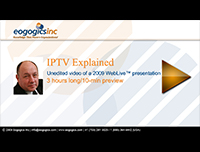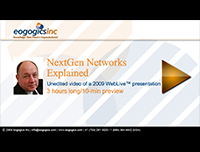Knowledge Center
Telecommunications
General
Optical Networking: Past and Future
Light-based methods have been used for information transmission for thousands of years. Probably the earliest method is the fires that have been used for signaling since Biblical times.Smoke signals have been used for communications for a long time, most notably by Native Americans. Lanterns hung in Boston’s Old North Church (“One if by land, and two if by sea”) figure prominently in Paul Revere’s famous midnight ride in 1775.
Related Courses :
Cyber Security: Next Pearl Harbor?
A spate of cyber-attacks, some of which were quite serious, have recently affected government agencies as well as businesses in a wide range of industries, including the CIA, US Senate, IMF, NATO, Google, Lockheed Martin, Sony, Citigroup, and others.
Related Courses :
SDN/NFV (Software Defined Networking, Network Functions Virtualization): Networking Game Changers?
The terms SDN (Software Defined Networks) and NFV (Network Functions Virtualization) have acquired magical connotations for those who work with networks but are not technical, raising many expectations. Are SDN and NFV really such a game changer for networking? SDN and NFV are among the half dozen or so technologies seeking to address the issues that trouble contemporary networks. The other major technologies in the mix include GMPLS, ASON, high-speed Ethernet, NGN, and OTN, with a good deal of overlap between the various solutions that have been proposed.
Related Courses :
Distributed Computing for IoT: Data Management in a Fog Computing Environment
Mobile cellular operators are making plans for Mobile Edge Computing (MEC), which enables Cloud computing capabilities and an IT service environment at the edge of the cellular network. It is a concept developed by ETSI (European Telecommunications Standards Institute) that aims to bring computational power into Mobile RAN (radio access network) to promote virtualization of software at the radio edge. MEC brings virtualized applications much closer to mobile users ensuring network flexibility, economy and scalability for improved user experience.
Related Courses :
- Onsite Training: Emerging Technologies, SDN, NFV, Cloud, Blockchain and General Networking
- Onsite Training: 5G Wireless, M2M, IoT, SDN, NFV, Cloud
- Onsite Training: Defense, Security, Public Safety
- Onsite Training: IoT, IPv6, VoIP, EoIP, IMS, MPLS, SNMP
- Onsite Training: M2M, WiFi, Bluetooth, Zig Bee, IoT
Check out our courses on 5G Wireless technologies, applications, and marketplace along with related courses on M2M and IoT.
Three Views of Quality of Experience
From the late 1700s to the early 1800s, the Japanese wood block artist Katsushika Hokusai created forty six wood block prints and, for reasons understood only by the artist, entitled the collection “Thirty Six Views of Fujiyama”.
Out with the Old, in with the New!
Happy New Year! I hope last year was as productive for you as it was for us. In 2010, we introduced four new curricula (IEEE WCET, Spectrum Management, OSS/BSS, Manufacturing Optimization, Human Resources) and enhanced nearly all of our existing curricula, making our 400+ course curriculum one of the largest, most up-to-date
The IoT and the Serious Security Risks It Poses
Introduction The Internet of Things (IOT) refers to the increasingly networked world we now inhabit, in which more and more “smart” devices use Internet to interact with other devices, servers, or with various users. It is not a new type of Internet, but an evolutionary development that shows how incremental technology growth can lead to…
Related Courses :
IP and Related
Blockchain and Other Cutting Edge Tech
Blockchain, the Distributed Ledger Technology behind Bitcoin, has attracted interest across many industries including financial services, legal, real estate, digital rights, identity management, healthcare, asset tracking, supply chain management, and the Internet of Things (IoT). A disruptive technology, it has the potential to transform the way many transactions are conducted.
Related Courses :
The Internet of Things (IoT) Revolution: Are You Ready?
Nearly every industry vertical stands to be transformed by the coming IoT revolution. The IoT technology is creating enormous opportunities for new services as well as more efficient delivery of existing services. The rapid pace at which this technology is evolving is also giving rise to major privacy/security risks for individuals, institutions, and public infrastructure — creating new vulnerabilities and giving rise to not-as-yet-thought-of attack modalities, including those of remotely engineered death and destruction.
Related Courses :
e-Learning Course – IPTV: For All Audiences (3 hours long)
This is a web-based video recording of the 3-hour long course webcast live on Oct 22, 2009. It’s aimed at those who need a quick, “technical light” introduction to IPTV.
MRI Is to Medical Diagnosis as Wireshark Is to Network Traffic Analysis and Troubleshooting
I really enjoy watching the TV show House. Not for Hugh Laurie’s award-winning sarcasm – which I find formulaic and annoying – but, rather, to watch the diagnostic process unfold. House is truly unique because the real star of the show might turn out to be leishmaniasis or schistosomiasis rather than Brad Pitt or George Clooney. I watch the team meetings and brainstorming with great interest, the whiteboard filling with symptoms, while the team postulates the cause.
Knowledge Make-Overs: Why Not IPv4/v6?
The fad these days is make-overs. The first in the trend were fashion make-overs where some hideously unattractive and under dressed person was transformed, through the miracle of modern cosmetology and fashion science, to a hideously over-made up and over-dressed person.
Check Out Our IP Curriculum
It covers IoT, IPv6 implementation, TCP/IP, Mobile IP, IP Security, BGP, MPLS, and more.
What I did on World IPv6 Day
Thursday, June 8th, 2011 was the Internet Society’s World IPv6 Day. Years from now will you remember where you were and what you were doing on this important day? While the events of World IPv6 Day are not etched as deeply into my memory as, say, the day Ronald Reagan was shot or the day…
The Internet of Things: Smart Devices, M2M, WSNs, and IoT
At its most basic level, IoT just connects simple devices over the Internet or other network which could be private and/or wireless. Common examples include the ‘program-from-anywhere’ thermostats and security systems already in use. At the mid-level, IoT is an enabler of new business and technology models, not just incremental improvement of existing ones. For example, autonomous vehicles will require very high levels of communication among devices in the vehicle (e.g., LIDAR, sensors, cameras, computers) and most likely devices/sensors outside the vehicle (e.g., other vehicles, fixed cameras, servers with detailed maps). At the highest level, the interconnection of devices could lead, over time, to new technologies that will reorganize the society, much as the automobile and the Internet have. One possibility is the “Smart City”, where IoT is used not only in autonomous vehicles, but where all types of transportation are linked to provide optimized people movement. Private self-drive cars, in this scenario, would rarely be needed. This could lead to entirely different land use patterns, for example.
Related Courses :
NextGen Networks
“When It Comes to Web 2.0 and Next Gen Communications, I’m with Tim … Pretty Much.”
Timothy Berners-Lee invented the browser and, subsequently, the World Wide Web. The impact of this browser thing of his is so profound that not only does it transform the way that everyone in the industrialized world interacts with each other, it inspired Her Royal Highness Queen Elizabeth – with but two taps of the royal sword – to transform Mr. Berners-Lee himself into Sir Timothy.
Related Courses :
e-Learning Course – NextGen Networks Overview: For All Audiences (1 hour long)
This is a web-based video recording of the 1-hour long course webcast live on Oct 7, 2009. It’s aimed at those who need a quick, non-technical introduction to Next Generation Networks.
e-Learning Course – NextGen Networks (NGN) Explained: For All Audiences (3 hours long)
This is a web-based video recording of the 3-hour long course webcast live on Oct 21, 2009. It’s aimed at those who need a quick, “technical light” introduction to Next Generation Networks (NGN).
IMS
Tutorial: Internet Multimedia Subsystem (IMS)
Communications networks are rapidly evolving into policy-based, packet-oriented networks designed to provide a particular quality-of-services (QoS) for subscribers while reducing the costs associated with capital expansions, network operations, and management. If you are involved with telecommunications planning, engineering, deployment, strategy, marketing, or services creation, it is critical that you understand the technology and business implications of IMS.
Related Courses :
SCIM Deployment Is Key to the Future of Next Generation Communications
Susie had been using Instant Messaging (IM) with her wireless carrier for eight months when she decided to add Push To Talk (PTT) as well. While she was quite happy with the first service, and had heard many good things about the second service from her friend, she was not at all satisfied with how the two services worked together—or rather didn’t work together.
VoIP
The Three C’s of VoIP: CODECS, Codes, and Convicts!
Anyone who has ever been engaged most certainly can list the four “Cs” of diamonds: Color, Clarity, Cut and Carat weight. But did you know that there are also three “Cs” of Voice over IP?
Related Courses :
Eogogics Courses on Multimedia Technologies
Check out our multimedia curriculum for courses on IMS, SIP, VoIP, and EoIP.
VoIP and the Art of Internet Search
If you plug VoIP into a search window, you are invariably led into a forest of technical specs — site after site of the latest in IP PBX’s, release 3.0 and 9.5’s, gateways, media servers, Internet Protocol, real-time protocol, and a yellow brick road with lions, tigers, and bears.
VoIP QoE, Ken Lay [formerly] of Enron, and “Photographic Evidence”
On the left side of the screen was Ken Lay being led off in hand cuffs. On the top was a quote from Mr. Lay: “But I told him to pass the books … not to pad them!”.
Related Courses :
Tutorial: Voice over IP (VoIP)
VoIP, Voice over IP, stands for Voice over the Internet Protocol. In VoIP, voice calls are packetized to allow the voice traffic to “ride over” the organization’s data network. This eliminates the need for a separate voice network with its dedicated voice circuits, thereby saving resources and costs.
VoIP: CxO 5 Minute VoIP Guru Guide
This 5-minute executive guide to VoIP presents a non-vendor perspective for decision-makers.
MPLS
MPLS and the Evolving Telecom Landscape
By 2010 both ATM and FR were in fairly steep decline, relegated to the status of legacy technologies. MPLS usage is growing and new applications for it continue to emerge, making it the technology of choice for most large-scale networks. Nowadays the great buzzword is “cloud computing”, with different versions such as Software as a Service (SaaS—Gmail, Google maps, YouTube, Facebook), Platform as a Service (PaaS—Amazon Elastic Compute Cloud, Windows Azure, Salesforce). All of these utilize MPLS-based networks.
Related Courses :
e-Learning Course – MPLS Backbone for Technical Audiences (6 hours long)
This is a web-based video recording of the 6-hour long course webcast live on Oct 28-29, 2009. It’s aimed at those who wish to develop a deeper understanding of Multiprotocol Label Switching (MPLS), related issues, and the competition.
Related Courses :
SNMP
TV Studios, Airborne Military Platforms, James Bond … and SNMP
Do you know what the following have in common: television broadcast studios, automated fare collection systems, airborne military platforms, energy distribution systems, and emergency radio networks? It’s SNMP, a protocol designed to manage a diverse set of networked equipment.
Related Courses :
Tutorial: Simple Network Management Protocol (SNMP)
Simple Network Management Protocol (SNMP) is a widely used protocol designed to facilitate the management of networked devices from a central location. Designed originally for the management of devices such as routers and switches, its usage has grown rapidly to encompass the monitoring of nearly any electronic device one can think of.
Related Courses :
Mobile Wireless Backhaul
Good Mobile Backhaul: There’s No App for That!
Mobile backhaul and wireless backhaul are two names for the same thing: the communications link between the practically ubiquitous cellular antennas on radio towers, buildings, highway signs, church steeples, fake Sequoyah trees and elsewhere that connect mobile subscribers to the carrier IP network and/or Internet.
Our Comprehensive Mobile Wireless Backhaul Curriculum
Includes making a business case for backhaul, application case studies, market, technology deep-dive, and security
Mobile Backhaul: The Missing Link
Mobile is hot and mobile backhaul is thriving. As the number of mobile devices grows the need to bridge the gap between the subscriber devices and the IP cloud grows and as the bandwidth demand increases the demand for a bigger bridge between the subscriber devices and the IP cloud also grows.
Mobile Backhaul “Mutual Fund” and Technology Trends
“I don’t follow any one mobile backhaul provider’s stock anymore, including my own – I just count the number of AT&T, Verizon and T-Mobile ads.” This comment was made by an admitted stock-a-holic who, it turns out, is a regional sales VP for a national backhaul provider.
Other Telecom
SDN/NFV: Enhancing Network Capacity and Functionality
SDN and NFV have been developed to help meet the challenge of increasing demand for services and user expectation of rapid provisioning and universal availability. Both rely on virtualization, the ability to make a piece of equipment look like another via the magic of software. SDN was originally developed to address the problems of large data centers, where virtualization of hardware and operating system is important. It will likely spread to other areas, including the WAN, where virtualization and the ability to dial up bandwidth and related characteristics would be extremely valuable as well. NFV is an outgrowth of SDN in many respects, concentrating on backbone networks, where the need to rapidly reconfigure resources is key.
Related Courses :
Tutorial – Optical Networks
As the name suggests, optical networks form a class of networks where optical, rather than electronic, components are the building blocks of the network. Compared to metallic cable, fiber optic systems offer greater bandwidths, lower attenuation, and no crosstalk or electrical interference.
Related Courses :
Tutorial – SS7 or C7: Signaling System #7
Signaling System #7 (SS7), also known as C7 in Europe, is a critical component of modern telecommunications systems. Despite the upcoming migration to IP networks and evolution to IP-centric architectures such as the IP Multimedia Subsystem (IMS), it remains the glue that binds all telecommunication networks together.
Related Courses :
The Internet of Things (IoT) Revolution: Are You Ready?

Powered by the expansion of connectivity fueled by IPv6, the Internet is quickly morphing from a ‘network of computers’ into a ‘network of things’, and this technology is developing at a much faster pace than other such technologies of the past. Smart phones, cars, homes, buildings, wearable computing devices, unseen but ubiquitous sensors embedded into appliances, equipment and infrastructure, and many other “things” (including living things such as cattle and wildlife) are all getting linked up into a vast and pervasive Internet of Things (IoT)! It’s a disruptive technology that — though largely invisible to consumers — will have profound impact on our everyday lives, how businesses operate, and on the world economy as a whole (multi-trillion dollars) — all in as little as five to 10 years.
Related resources:
Article: Distributed Computing for IoT: Data Management in a Fog Computing Environment
Course: Internet of Things Workshop
Research publications on IoT (look for ‘IoT’ in our Store‘s ‘Search Product’ field)
Nearly every industry vertical stands to be transformed by the coming IoT revolution. The IoT technology is creating enormous opportunities for new services as well as more efficient delivery of existing services. The rapid pace at which this technology is evolving is also giving rise to major privacy/security risks for individuals, institutions, and public infrastructure — creating new vulnerabilities and giving rise to not-as-yet-thought-of attack modalities, including those of remotely engineered death and destruction. Yet, many businesses and government agencies wonder if this is all passing hype — which it is not — and many do not know how the IoT should fit into their organizational strategy.
So is your organization positioned correctly to benefit from this coming Internet of Things (IoT) revolution? Starting with this issue of the Eogogics Quarterly, we will be publishing a series of articles, courses, and research publications to help our readers better understand the underlying technologies, business and societal impact, potential, and market landscape of the Internet of Things (IoT). Featured in this issue are an article on distributed computing for the IoT and an update on the new courses and research publications on IoT that have been recently added to our product line-up. Are there IoT issues you’re interested in that are not covered by our courses and research publications? Call us (+1 703 345-4375) or drop us a line at info@eogogics.com. We may be able to help.
















